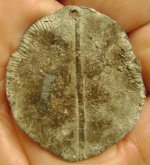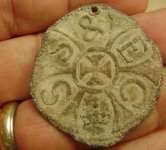SPWalker
Jr. Member
I have a friend that picked up a coin looking item along the Rio Grande River about 100 miles from the Gulf Coast. Looks very old. He tells me that - Seems to be stamped on lead, no inscription on the back.....about the size of a silver dollar, thin. The back is rather plain, It has the “serration” pattern around the edge and a single ridge vertical down the middle, the back was up when I saw it and I thought it was a strange shaped leaf. I had no real reason to pick it up, but something said so......
Any idea what it could be? I am thinking Spanish colonial in origin.
Thank you for looking.
SW
Any idea what it could be? I am thinking Spanish colonial in origin.
Thank you for looking.
SW
Attachments
Upvote
0





